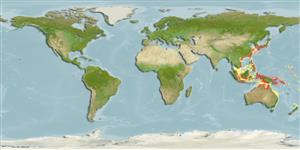>
Ovalentaria/misc (Various families in series Ovalentaria) >
Pomacentridae (Damselfishes) > Chrominae
Etymology: Chromis: Greek, chromis = a fish, perhaps a perch (Ref. 45335); albicauda: Name from Latin meaning 'white tail' for its diagnostic feature that separates this species from Chromis analis.
Environment: milieu / climate zone / depth range / distribution range
Écologie
marin récifal; profondeur 25 - 70 m (Ref. 90102), usually ? - 30 m (Ref. 82433). Tropical
Western Pacific: Indonesia and southern Japanese seas; distribution probably disjunct due to association with cool temperature regimes.
Taille / Poids / Âge
Maturity: Lm ? range ? - ? cm
Max length : 13.4 cm SL mâle / non sexé; (Ref. 82433)
Description synthétique
Clés d'identification | Morphologie | Morphométrie
Épines dorsales (Total) : 13; Rayons mous dorsaux (Total) : 11 - 12; Épines anales: 2; Rayons mous anaux: 11 - 12. This species is distinguished by the following characters: D XIII,12 (rarely 11); A II,12 (rarely 11); pectoral rays 18-20; spiniform caudal rays 3; tubed lateral-line scales 17-19; gill rakers 7-8 + 24-26, total rakers 24-26; body depth 1.8-1.9 in SL; edge of suborbital hidden by scales; 4-5 scale rows on anterior portion of preorbital; generally yellow in life, grading to brown on upper back with abruptly white caudal fin; blackish anal opening which is also evident in preserved specimens (Ref. 82433).
Adults are commonly observed in areas of cool (18°-24°C) upwelling along the northern and western shores of Nusa Penida at about 25-50 m. They typically form aggregations, which feed high in the water column on zooplankton when currents are strong (Ref. 82433). Oviparous, distinct pairing during breeding (Ref. 205). Eggs are demersal and adhere to the substrate (Ref. 205). Males guard and aerate the eggs (Ref. 205).
Life cycle and mating behavior
Maturité | Reproduction | Frai | Œufs | Fécondité | Larves
Oviparous, distinct pairing during breeding (Ref. 205). Eggs are demersal and adhere to the substrate (Ref. 205). Males guard and aerate the eggs (Ref. 205).
Allen, G.R. and M.V. Erdmann, 2009. Two new species of damselfishes (Pomacentridae: Chromis) from Indonesia. aqua, Int. J. Ichthyol. 15(3):121-134. (Ref. 82433)
Statut dans la liste rouge de l'IUCN (Ref. 130435: Version 2024-2)
Menace pour l'homme
Harmless
Utilisations par l'homme
Pêcheries: pêcheries vivrières
Outils
Articles particuliers
Télécharger en XML
Sources Internet
Estimates based on models
Phylogenetic diversity index (Ref.
82804): PD
50 = 0.5000 [Uniqueness, from 0.5 = low to 2.0 = high].
Bayesian length-weight: a=0.01820 (0.00804 - 0.04119), b=2.99 (2.81 - 3.17), in cm total length, based on LWR estimates for this Genus-body shape (Ref.
93245).
Niveau trophique (Ref.
69278): 3.0 ±0.1 se; based on size and trophs of closest relatives
Résilience (Ref.
120179): Milieu, temps minimum de doublement de population : 1,4 à 4,4 années (Preliminary K or Fecundity.).
Fishing Vulnerability (Ref.
59153): Low vulnerability (10 of 100).
